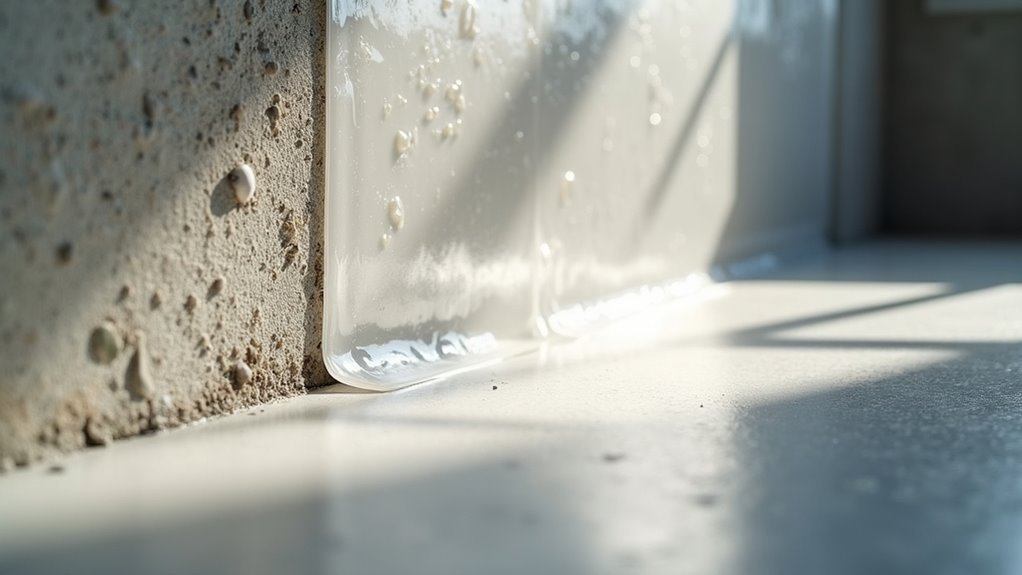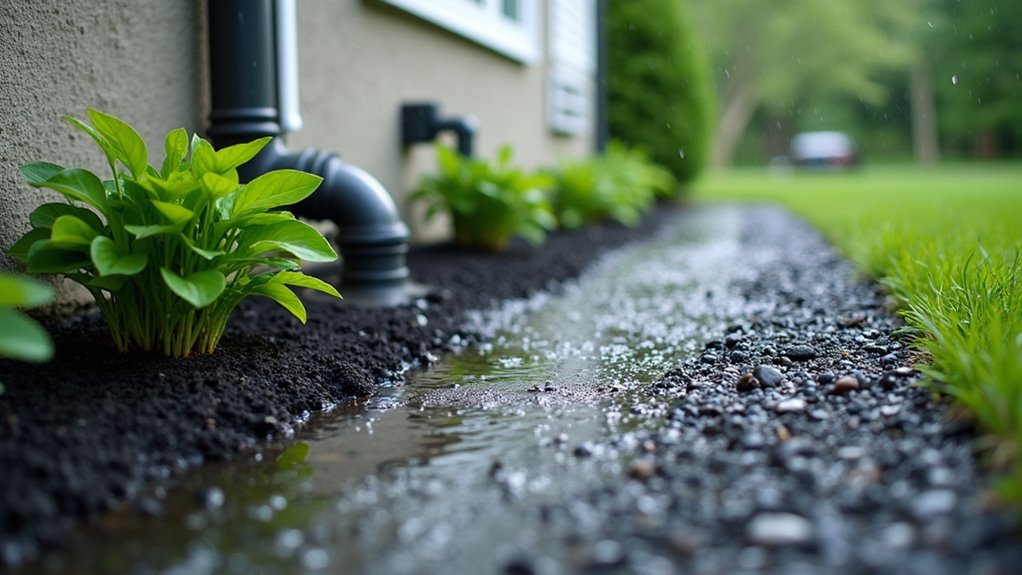You can prevent basement pests by controlling moisture through seven key solutions: install interior drainage systems and sump pumps to redirect water, use dehumidifiers to maintain humidity below 50%, apply vapor barriers to foundation walls, fix gutters and downspouts for proper water diversion, improve exterior grading so soil slopes away from your foundation, seal foundation cracks and entry points, and implement regular moisture monitoring with weekly humidity checks. These all-encompassing strategies create an environment that’s hostile to moisture-loving pests seeking damp shelter in your basement.
Install Interior Drainage Systems and Sump Pumps

One of the most effective ways to combat basement moisture is installing interior drainage systems paired with sump pumps.
These systems feature perforated drain pipes around your basement’s perimeter footing, redirecting water away from your foundation to prevent flooding and moisture buildup.
Your sump pump becomes the system’s workhorse, removing excess water that collects in the sump basin.
This combination maintains a dry environment and greatly reduces humidity levels, making your basement less attractive to moisture-loving pests like cockroaches and silverfish.
During heavy rainfall, properly designed systems handle substantial water flow, keeping your basement structurally sound while avoiding costly repairs.
You’ll need regular inspections and maintenance to guarantee ideal performance and prevent failures that could lead to pest infestations.
Use Dehumidifiers to Control Humidity Levels
You’ll want to maintain basement humidity levels below 50% to create an environment that discourages pest infestations and mold growth.
Strategic placement of your dehumidifier is essential for maximum effectiveness throughout the space.
We’ll explore the ideal humidity targets you should aim for and share key placement tips to guarantee proper air circulation and moisture removal.
Optimal Humidity Target Levels
Maintaining basement humidity levels below 50% creates an inhospitable environment for common pests like cockroaches and silverfish that thrive in moisture-rich conditions.
A quality dehumidifier can help you achieve this ideal target range consistently. You’ll want to monitor humidity levels regularly using a hygrometer to verify your moisture issues stay under control.
Choose a dehumidifier with appropriate capacity for your basement size, typically measured in pints per day.
During particularly humid months, run your unit continuously to keep your basement dry and pest-free. This consistent moisture control markedly reduces the likelihood of infestations by eliminating the high-humidity environments these unwanted visitors need to survive and reproduce in your home.
Strategic Dehumidifier Placement Tips
Where should you position your dehumidifier for maximum effectiveness? Place dehumidifiers in your basement’s lowest areas where humidity naturally settles and accumulates. This strategic positioning guarantees you’re targeting the most moisture-prone zones to prevent pests like cockroaches and silverfish from establishing themselves.
Don’t position units directly against walls or furniture – you’ll limit airflow and reduce moisture extraction efficiency. Instead, allow adequate space around each dehumidifier for proper air circulation throughout your basement.
For larger basements or severe moisture problems, you’ll need multiple dehumidifiers to achieve thorough humidity control.
Remember to regularly empty collection tanks or connect drainage systems to maintain continuous operation. This prevents moisture buildup that could undermine your pest prevention efforts and compromise your basement’s environment.
Apply Vapor Barriers to Foundation Walls

While moisture can infiltrate your basement through various pathways, applying vapor barriers to foundation walls creates one of the most effective defenses against humidity-related pest problems.
These polyethylene sheets block water vapor from penetrating walls, keeping your basement considerably drier and less appealing to unwanted visitors.
You’ll need to seal all seams and edges carefully during installation to guarantee continuous protection against moisture intrusion.
Any gaps or tears will compromise the barrier’s effectiveness, allowing humidity to create conditions that attract pests.
A properly installed vapor barrier dramatically reduces mold and mildew growth, eliminating the damp environments where many pests thrive.
Regular inspection and maintenance of your barriers guarantees long-term protection, preserving the dry conditions essential for effective pest prevention.
Fix Gutters and Downspouts for Proper Water Management
When gutters and downspouts fail to function properly, they create the perfect storm for basement moisture problems that attract unwanted pests.
You’ll need to clean your gutters regularly to prevent blockages that cause overflow and water accumulation near your foundation. Make sure your downspouts extend at least 6 feet away from your home’s foundation to effectively channel water away and minimize moisture intrusion.
Install splash blocks or drainage systems at downspout bases to further divert water from your foundation and prevent damp conditions.
You should inspect and maintain your gutters and downspouts regularly to prevent pests by controlling water flow. This proactive approach greatly reduces moisture-related pest problems in your basement while protecting your home’s structural integrity.
Improve Basement Grading and Exterior Drainage

You’ll need to grade the soil around your foundation so it slopes away at one inch per foot to direct water away from your basement walls.
Your gutters and downspouts must extend far enough from the foundation to prevent water from pooling near the base of your home.
Don’t forget to improve your window well drainage by adding coarse aggregate and drain tile extensions that’ll keep water from getting trapped against the foundation.
Proper Foundation Slope Grade
Since water naturally flows toward your foundation when the ground slopes incorrectly, establishing proper grading becomes your first line of defense against basement moisture problems.
You’ll need to create a proper foundation slope grade that directs water away at a minimum slope of one inch per foot. This prevents water accumulation near your basement walls, which would otherwise create moisture problems that attract unwanted pests.
Inadequate grading concentrates water flow toward your foundation, creating the perfect environment for pest infestations.
You should regularly inspect and adjust your landscaping slope to maintain effectiveness. By ensuring water flows away from your home consistently, you’ll eliminate the damp conditions that create pest-friendly conditions around your foundation and protect your basement from moisture intrusion.
Gutter Downspout Installation
While proper foundation grading creates your first defense against moisture, installing gutters and downspouts establishes your second critical barrier by capturing and redirecting rainwater before it can saturate the soil around your basement walls.
You’ll want to make sure your downspouts extend at least 6 feet from your foundation for effective drainage. This distance prevents water from pooling near basement walls, where it’d create the damp conditions that attract pests.
Regular gutter maintenance is essential—clean out debris that causes blockages and overflow.
You can enhance your moisture management by combining gutter downspout installation with drain tiles for thorough water control. This integrated approach greatly reduces basement humidity levels, making your space less appealing to moisture-loving pests like silverfish and centipedes while preventing costly water damage.
Window Well Drainage
Although window wells protect basement windows from soil pressure, they can become water collection points that create serious moisture problems if not properly drained.
Poor window well drainage leads to water accumulation against your foundation, creating moisture issues that attract cockroaches and termites to your basement.
Effective basement waterproofing requires proper window well management:
- Install drain tile extensions to redirect water away from your foundation and minimize flooding risks.
- Use coarse aggregate in window wells for better drainage and reduced water pooling.
- Grade properly around wells with at least 1-inch slope per foot to promote water runoff.
Regular maintenance keeps debris from obstructing drainage systems.
Clean your window wells seasonally to prevent pests and maintain dry basement conditions year-round.
Seal Cracks and Entry Points in Foundation
When you discover cracks and gaps in your foundation, you’re looking at prime entry points for both moisture and unwanted pests. Even tiny openings allow cockroaches and termites to infiltrate your basement.
Foundation cracks create perfect highways for moisture and pests like cockroaches and termites to invade your basement space.
You’ll need to seal cracks using high-quality caulk or foam insulation around windows, doors, and foundation walls to create an airtight environment that prevents moisture buildup.
Regular inspections are essential since foundation settling and weather changes create new openings pests can exploit.
Apply waterproof sealants to make your basement less inviting to moisture-loving insects.
Don’t forget to properly seal excess space around window wells with coarse aggregate and drain tile extensions. This prevents water accumulation and deters pests like camel crickets that seek damp shelter areas.
Implement Regular Moisture Monitoring and Maintenance
After sealing foundation entry points, you must establish a consistent monitoring system to maintain ideal moisture levels and protect your investment.
Regular inspections help you catch problems before they escalate into costly repairs or pest infestations.
Essential Monitoring Steps
- Check moisture levels weekly using moisture meters to gauge readings within walls and floors, keeping humidity below 50%.
- Inspect damp areas monthly for musty odors, visible mold, or water stains that signal developing moisture problems.
- Maintain equipment quarterly by servicing dehumidifiers, sump pumps, and drainage systems to guarantee peak performance.
Keep detailed records of your moisture readings and maintenance activities.
This documentation helps you identify patterns and recurring issues that might require professional intervention, ultimately saving you money on extensive repairs.
Frequently Asked Questions
What Is the Best Waterproofing Method for Basements?
You’ll achieve best results by combining interior drainage systems with sump pumps, installing vapor barriers, applying exterior waterproof sealants, maintaining proper foundation grading, and regularly inspecting gutters to redirect water away.
How Do I Bug Proof My Basement?
You’ll need to seal all cracks with caulk, maintain humidity below 50% using dehumidifiers, declutter regularly, store items in airtight containers, and use natural deterrents like peppermint oil.
What Absorbs Moisture in a Basement?
You’ll find dehumidifiers work best for removing moisture from basement air. Desiccants like silica gel, activated charcoal, and calcium chloride also absorb humidity effectively when placed in containers throughout your space.
Will a Dehumidifier Get Rid of Bugs in the Basement?
A dehumidifier won’t directly kill existing bugs, but it’ll create conditions they can’t survive in. By reducing humidity below 50%, you’ll force moisture-loving pests like cockroaches and silverfish to relocate elsewhere.
In Summary
You’ve got everything you need to tackle basement moisture and keep pests away. Don’t wait until you’re dealing with an infestation – start implementing these solutions now. Focus on the most critical issues first, like major leaks or poor drainage, then work your way through the other fixes. Remember, moisture control isn’t a one-time job. You’ll need to stay on top of maintenance and monitoring to keep your basement dry and pest-free long-term.





Leave a Reply